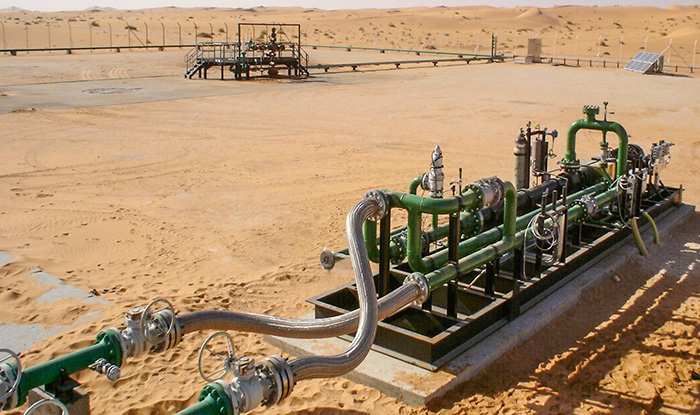Compressors alone generally cannot handle liquids and solids. This presents a challenge to oil and gas production operations, since most wells output a combination of sand, oil, water and gas—also called a multiphase fluid flow. Typical local batteries will include a separator (which includes water or solids removal), a compression module, a liquid pump, equipment to allow flaring and separate pipelines used to transport the oil, water and gas to a production facility. To combat rising equipment costs and enable increases in production, one company introduced a multiphase pumping system.
The multiphase system is a complete package comprised of a progressing cavity-type pump, a drive, a seal lubricator, pressure and temperature sensors, and a control package. The system includes an inlet pressure range from 5 to 1,000 pounds per square inch gauge (psig) (with seal arrangement as required), handles pressure up to 750 psi and has a capability per pumping unit to deliver up to 2,350 gallons per minute (gpm) of total equivalent flow rate.
Due to its design, the multiphase pumping system can handle large amounts or high percentages in gas volume fraction up to 99 percent. The multiphase system comes with the standard materials required to meet most applications:
- Rotor – 316SS with tungsten carbide coating
- Stator – Buna nitrile (hydrogenated nitrile)
- Mechanical seal – double cartridge (engineered seal, API 682 intent)
- Seal lubrication as required – ANSI Plan 53 (API Plan 53A, Plan 54)
- Gearbox – Shaft-in/Shaft-out, Class II gears (belt/pulley available)
- Motor – Premium efficient, severe duty, fan cooled, 50 or 60 Hz
 Image 1. An operator in North Africa found such a substantial increase in production by using a multiphase pumping system that it was put to use on 15 additional wells. (Image courtesy of NOV)
Image 1. An operator in North Africa found such a substantial increase in production by using a multiphase pumping system that it was put to use on 15 additional wells. (Image courtesy of NOV)Additionally, its remote control station, with programmable logic controller, synchronizes with satellite communications to allow users to monitor equipment and process data remotely in real time.
This means that response teams can be immediately alerted and sent to the production site in case of alarms. Working parameters can also be changed remotely, equipment can be shut down or restarted, and daily reports can be delivered and printed.
The primary benefits of multiphase pumping are accelerated production and less need for expensive battery equipment. Multiphase pumps substantially reduce the backpressure on the producing formations, allowing the formation to produce more effectively.
They overcome the typical backpressure from downstream pipelines and facilities and can be used with either free-flowing wells or those using artificial lift systems, including with rod pumps, submerged pumps or progressing cavity pumps. The multiphase pump acts as a valve to take the flowline pressure off the wellhead or separator, with the resultant decrease in pressure on the wellhead improving the output of the well.
Multiphase pumping systems also eliminate the need to erect expensive battery equipment since new wells simply tie into existing batteries. This, and the potential to eliminate line looping, can save users millions of dollars.

The following are two stories of success using the system.
- In Canada, an operator had a large well field with only one central processing facility (battery). The field included several dominant wells, and excessive flowline pressure was causing the wells to shut down. The multiphase pumping system was perfect for this field design, as the system more effectively handled multiphase fluids containing solids and heavy oil. After implementing the multiphase pumping system, the operator saw an increase in production of 500 barrels of oil per day (BOPD).
- An operator in North Africa had a field with aging wells that were still capable of producing oil. The operator needed to find an alternative solution to gas flaring and determined that a multiphase pumping system would be a fit. An initial pilot project, which used two 250-horsepower multiphase pumps, yielded an increase in production of approximately 2,500 BOPD. The increase was so substantial that the operator ultimately decided to use the multiphase pumping system on 15 additional wells.
As the demand for more economical production increases, multiphase pumping will likely continue to gain traction as a powerful production method. In addition to the cost and production benefits, there are also environmental benefits. Multiphase pumps can provide for nearly zero gas flaring, and gas can be transferred to a remote processing facility.


